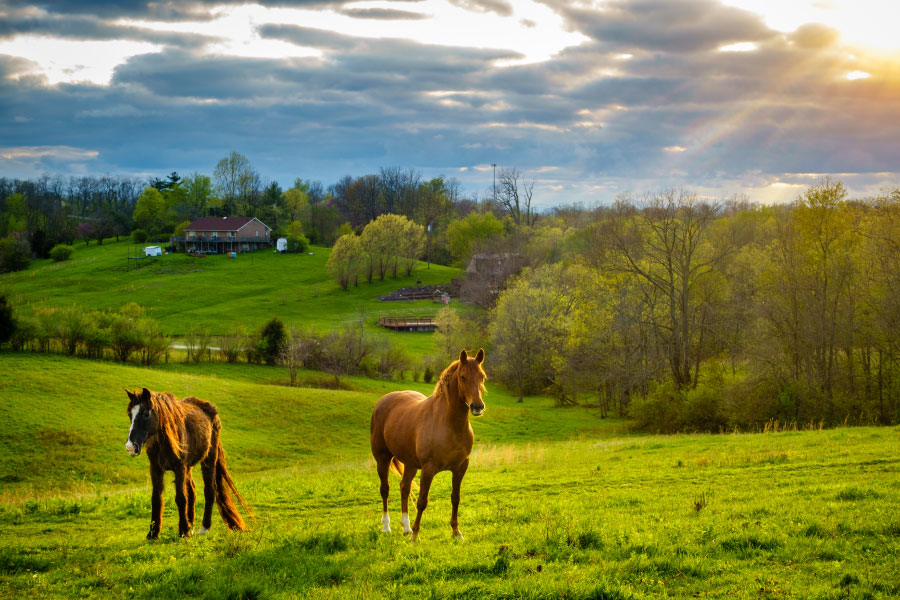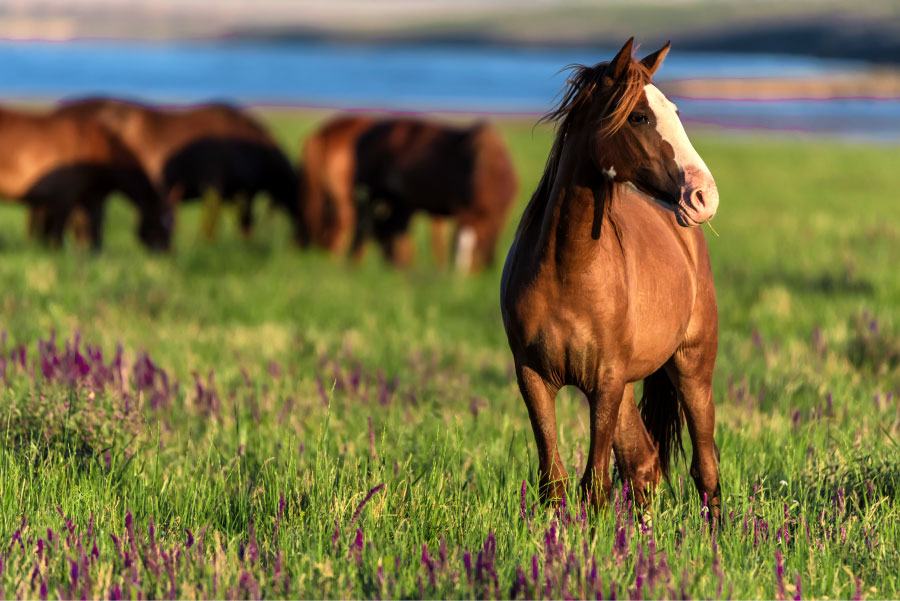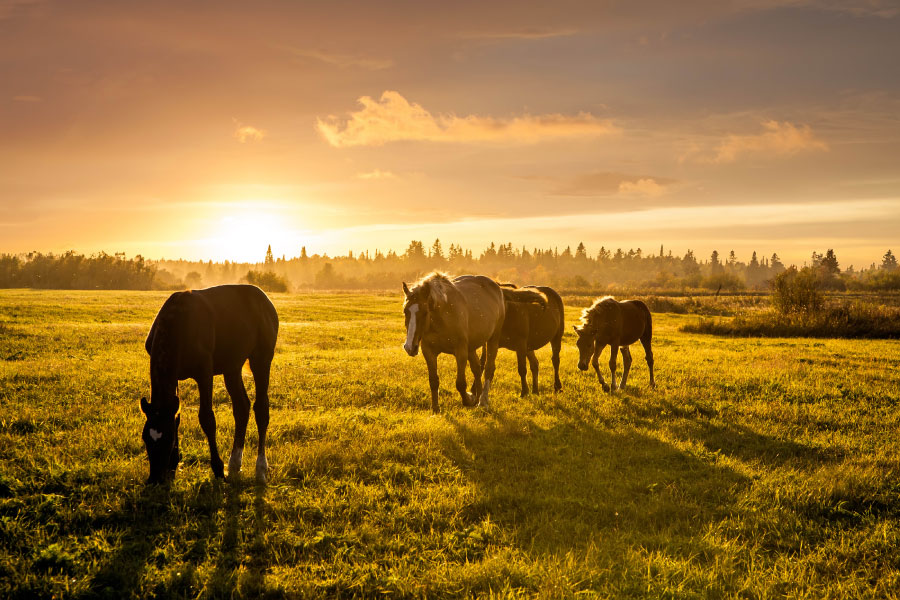
The amount of land needed to pasture a horse humanely is a matter of conjecture among horse owners. The main reason you’ll get so many different answers to a relatively straightforward question is that the amount of land you need for a horse depends on many different variables.
When stocking horse pastures, the standard rule is to provide two acres per horse. However, the amount of land needed to pasture a horse depends on several factors, such as:
- Geographic location and climate
- The conditions of the forage
- The type of horses
- Grazing rotation and other management methods
- Other livestock on pasture with the horses
A horse owner operating a massive horse breeding operation in arid Nevada will be dealing with significantly different challenges in setting up pasture than a hobby farmer in North Carolina with only a handful of horses to tend to. Keep reading to learn more about the factors that affect how much land a horse needs to thrive.
How Much Land Does a Horse Need?
The land needed for a horse varies significantly from region to region. Still, there are a few basic rules that are set forward to guide people trying to stock their grazing land based on the median necessities of the animals and how many pounds of food they are expected to forage in a given day.
Many amateur horse owners think that if they turn out a horse onto several acres of pasture, the amount of supplementary feed necessary to care for the horse is diminished. Unfortunately, this is a misconception that can lead to the horse’s health degrading quickly.
Without access to high-quality forage as well as supplementary feed and hay, horses will starve and eventually succumb to both internal and external parasites.
Feel free to check out our article on “Can a Horse Live on Hay or Grass Alone” here for more on this.
The Two-Horses-Per-Acre Rule
Regardless of the grazing conditions, the consensus among horse owners is that each horse requires approximately 1.5 to 2 suitable acres of grazing land to sustain itself.
You must be aware, though, that this rule only applies if the pasture in question has been intensively managed, with unpalatable weeds removed and good forage either seeded or encouraged through fertilization and land management practices.
What Factors Impact the Quality of Grazing Land?
The amount of land you need for a horse decreases with the quality of the land. Horses are very damaging and hard on pasture, so it is vital to ensure that the horses on it have enough grass to forage. Several factors impact the quality of grazing land for horses. Here are some of the things that need to be considered:
- Weeds: Weeds in grazing land can pose several problems for horses. Some common weeds such as nightshade and ragwort are poisonous to horses in large quantities and can cause irreparable organ damage. Weeds also crowd out real grass in pastures that have been overgrazed, leading the land to have an increasingly diminished amount of forage.
- Drought: Lack of rain can have severe negative impacts on the amount of grass and forage available in a pasture to horses since they require the greenest, most tender part of the grass. In arid climates where droughts are frequent, horse owners need to provide plenty of supplemental feed and hay to make up for the lack of natural forage during dry times.
- Heavy rains: Too much rain can be almost as bad for grazing land as not enough of it, especially in small horse pastures. In periods of prolonged rains, horses can quickly trample a small pasture into a mud wallow, rendering any forage in the pasture nearly inedible. This is one of the reasons that horses should be heavily supplemented with hay and feed in the winter, no matter what kind of geographic conditions the horses are being held in.
- Snowstorms and freezing temperatures: Not only will horses require more feed to keep themselves warm and ward off illness during cold weather, but heavy snows will kill off any remaining forage in a pasture, meaning that snowbound horses will have to be supplemented with hay and feed in addition to grazing land.
- Water access: Proper irrigation and water sources on a piece of grazing land are a double-edged sword in horse pasture management. Natural water sources usually do an excellent job of helping maintain good grass for forage and give horses a place to drink or bathe at their leisure. However, there are usually laws in place to protect local water sources from horse-related pollution, as horse manure is considered a serious water pollutant.
Seasonal weather and pasture conditions can significantly impact the amount of forage that a horse can get through its efforts before needing extra feed from its owner, and prolonged periods of wet weather can damage pasture if horses continue to forage on it. Therefore, managing grazing land properly is crucial to ensuring that as much forage is derived from a small pasture as possible to keep horses happy and healthy.
While horse owners don’t have much control over the weather that rolls through their pastures from year to year, knowing what kind of weather conditions are common in your area is one of the most important things to consider when deciding how many horses you can keep on your land.
It’s much better to overestimate the amount of forage you’ll need rather than struggle to feed your horses adequately after underestimating it. Managing horse land properly ideally begins well before you ever purchase a horse and lead it through the gates of your pasture.

What Factors Impact the Amount of Grazing Land Needed?
In addition to the factors that impact how “good” grazing land is for horses (and subsequently how much of it you need to forage them on it adequately) you also have to consider what factors impact the amount of grazing land you need.
Here are some of the different things you need to think about when deciding how many horses you can put on your land:
- Geographic location: The amount of forage available in a temperature region per acre will be much different than the same amount of acreage in an arid region. In arid or desert regions, horses main require two or three times as much pasture to gain the same amount of forage in a much smaller amount of land in a more temperature climate.
- Food and forage conditions: The type of forage available on a piece of land dramatically impacts how much sustenance horses will be able to get out of it. A well-managed pasture that has been seeded with nutritious ground cover such as alfalfa hay will be much better for sustaining horses (and will be able to sustain more horses comfortably) than a fallow lot that has been overrun with weeds and other unpalatable forage.
- Management and care: Different types of horses (and those raised for different purposes) require varying amounts of food and care. A herd of wild mustangs on wildlife management acreage can fend for itself much more easily (and subsist on smaller amounts of forage) than horses raised in an intensive breeding program or horses raised for specialty services, such as racing or show.
The many variables that affect the grazing land for horses necessitate a careful inspection of any property where there are plans in place for horses to be stocked. It is much easier to assess a pasture and find it wanting and amend it to be suitable to horses before horses are placed into it, rather than trying to fix lousy pasture management practices after the fact.
Smaller Horse Pastures Require More Maintenance
The good news for small farm holders is that horses can be happily maintained on just a few acres of land, as long as that land is managed correctly.
However, the smaller acreage you have available to pasture horses, the more intensive management that land will need. You must consider the extra amount of work needed to make a small pasture suitable for a horse, especially if you plan to keep more than one.
Manure and Small Pasture Management
One of the biggest challenges of keeping horses on a small amount of land is that horse manure builds up quickly, and this can compromise the quality of the grazing. Here are some of the ways that manure piles can negatively impact a small pasture:
- Manure piles can kill off the grass, leaving the pasture more susceptible to weed overgrowth and other problems.
- The build-up of manure near water sources such as wells, springs, lakes, wetlands, ponds, and water tables can result in pollution and even cause the pasture’s owner to be fined if they live in an area with regulations to protect local water sources from pasture contaminants.
- Manure build-up can cause offensive odors that can make a pasture less pleasant to visit and can both diminish property value and irritate neighbors.
- Piles of manure attract barnyard pests such as flies and rats. If horses have an injury, an infestation of flies due to excessive manure in the pasture can increase the chance of flystrike. Even if flies don’t end up festering in a wound, swarms of flies will bite and harass horses, diminishing their quality of life.
The good news is that on a small piece of pasture land for horses, the management practice of simply going around and manually removing the manure—as tedious as it might seem in the moment—can lend its own set of benefits in the form of excellent compost for the farm garden.

Soil Testing and Small Pasture Management
While soil testing is more often associated with horticultural practices on farmland, soil testing pasture before installing livestock is also a vital part of land management.
Not only can soil testing give you a general idea of the amounts of pathogens or pollutants that are present in the soil, but they can also give indications of what kinds of fertilizer and other amendments could be used on the land to make it more fertile. The more thick, healthy grass can be grown on a piece of land, the more horses it will reasonably support.
Before horses are moved onto a piece of land, you should take a portion of the soil to your local farming cooperative or extension. Soil tests can often be performed through these extensions either for free or for a nominal fee.
Here are the instructions for obtaining a pasture soil sample:
- Walk through the pasture in an M-shaped pattern across the length of the entire pasture, taking a shovel or soil probe with you. Bring a bucket with you.
- At each of the turning points in the M shape, take a soil sample. Remove sod and dig down six inches with the shovel or soil probe. Place a shovel full or probe full of soil in the bucket.
- Once soil samples have been taken from each of the “M” points, take these individual soil samples and mix them thoroughly in the bucket with the shovel handle or probe.
- Take a zip-up sandwich bag and fill it with a portion of the soil in the bucket. This is your subsample to be sent to a farming extension lab for testing.
For those who would rather do soil testing at home for basic parameters rather than waiting for soil testing results from a lab, there are soil testing kits available for purchase where you can do the analysis yourself.
Not only can a soil test give the horse owner a good baseline profile to figure out what their pasture conditions are, but it can also give them a jumping-off point to figure out how to rehabilitate the grazing land over the long-term for better forage in the future.
Managing Horse Land for Optimal Grazing
Keeping horses on a small amount of land can be done, but it does require some intensive pasture management practices that aren’t as necessary when horses are kept in more abundant pastures.
Here are some of the various practices that can help horse owners maintain good grazing pasture:
- Pasture rotation: When horses are kept on a minimal amount of land, one way that horse owners can help protect their pasture from overgrazing is to set up a system of pasture rotation. This is typically achieved through a series of temporary fencing measures that only allow horses to graze a specific area of the acreage at a time.
- Dry lots and sacrifice paddocks: Dry lots (also known as sacrifice areas or sacrifice paddocks) are a way for small landholders to “rest” areas of pasture and allow the graze to grow back to a reasonable length before allowing horses to graze on it again. Once the grass has been grazed down to three or four inches, it must be allowed to recover, or the grass will be grazed to death. While pasture is being rested, horses are confined to a “dry lot” where they are fed hay and grain only.
- Turning out/stabling: One way to manage how much horses graze on a piece of small acreage, especially when multiple horses are kept, is to only “turn out” one horse at a time onto the pasture to graze, leaving other horses either stabled or in a dry lot. This practice minimizes the amount of grazing damage horses can do at any given time, giving the grass a chance to recover.
- Withholding pasture: Ideally, horses shouldn’t be turned out onto fresh grass in the spring until the grass has had several weeks to establish itself. Horses may over-indulge on fresh forage for the first few weeks of access, leaving them vulnerable to illnesses like colic or laminitis. Horses should be restricted in access until they become accustomed to the change in feed. However, they will need adequate supplemental feed to make up the difference.
Maintaining horses on a smaller lot can be a little more labor-intensive than keeping them on dozens of acres. Still, it can be done successfully as long as management methods are undertaken with consistency in every growing season.

Advantages of Correct Pasture Management for Horses
Aside from ensuring that horses have enough to eat, there are many other advantages to the landowner for correctly managing their pasture. These are some of the benefits of proper pasture management when raising horses:
- Healthier, happier horses: Aside from just having enough to eat, horses that are allowed plenty of space to run around, browse at their leisure, and generally perform their natural behaviors are better behaved and more comfortable to manage than horses that spend the majority of their time cramped in a dirt paddock.
- Fewer maintenance costs in feed: The better pasture and forage for your horses is managed, the less grain and supplemental hay you’ll have to provide during spring and summer months, which can significantly decrease the costs of feeding a horse throughout the year.
- Fewer problems with parasites and other illnesses: Making sure that horses have plenty (and consistent) access to forage as well as making sure that pasture doesn’t become too beaten down with mud and dead grass. This can help prevent many horse-related illnesses such as laminitis, colic, and internal parasites.
- Higher stocking limits: The better pasture is and the more palatable forage it has on it, the more horses you can comfortably keep on a small amount of land. This doesn’t mean that you should cram as many horses on a piece of land as humanly possible, but it does give horse owners a little more wiggle room for maintaining more horses.
- Better looking pasture: Not only does appropriately managing grazing land ensure that there is plenty of forage available for horses to feed on, but it also keeps pastures looking fresh, green, and picturesque. Many prospective horse owner’s dreams of horses galloping across lush verdant fields have been smashed flat by the sight of a muddy, trampled-down lot a few months down the road, the inevitable result of improper land management.
It is essential to be reasonable when considering how many horses you can keep and how the land is kept. Otherwise, conditions in the paddock can deteriorate quickly, especially on fallow or undeveloped pasture.
Keeping Enough Land for Horses is Crucial for Their Health
One of the most common welfare issues in horse management is the problem where small landholders try to keep too many horses on not enough land. Not only does this quickly destroy the land, leaving the horses with nothing to graze, but it can also prevent horses from being efficiently kept on the pasture for seasons to come if it isn’t taken care of ahead of time.
